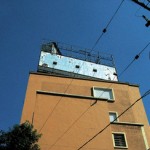Thank God that good things still happen on Earth. After I have written so many articles against aggressive advertising and against the nonsensical way of dealing with this issue in our country, here is the solution that I personally believe is a real perestroika. In short, the advertising law in Sao Paolo is working and, except for advertisers, nobody seems to notice any of its shortcomings; on the contrary, it is one of the most popular and the most publicly supported laws anyone has ever heard of.
According to an article in Herald Tribune, it’s a victory of the community values, of the social, of the public interest over the private. Therefore, I most gladly share it with you, since it’s so clear and to the point that it’s impossible for you not to like it.
But here is the story: approved by a vote of 45 to 1, the advertising law has been working for almost a year in this city; it provides that all the billboards, banners and coloured plastics, these so-called commercials, shall be eliminated. Moreover, even the distribution of fliers is considered illegal (my mailbox has been stuffed with election fliers this evening; I’m waiting for the day of revenge). What was the reason? What else than the visual pollution of the city. The same ban applies to the bumper stickers on the taxis and buses or to the banners flown over the city, despite some peoples’ complaints that the City Hall is not allowed to regulate the airspace, but only the ground surface… Anything that harms our eyes is now put on the blacklist in Brazil, Sao Paolo. And for things to be clear, a very strict standard was imposed on shop fronts regarding the size of the advertisements they are entitled to. In any case, it is directly proportional to the size of their front and to the taxes they pay. Therefore, the law limits, from the start, any advertising sign to normal dimensions; the proportion is something like: only 4 m2 out of 100 m2 can be used for commercial purposes.
A city of 11 million inhabitants, having Latin blood on top of everything (we’ve got no excuse left), under advertising attack, has started a revolution. On flikr you can find Tony de Marco’s photoset (search on google “sao paolo no logo”); you will see something that I, for one, would honestly want to happen to us too: a city with a new horizon. As for the houses, blocks of flats and streets in general, as pauper as they might be, they are much better off with no advertising, as everybody says in unison.
The mayor Gilberto Kassab says that any attempt of approaching the subject in a subtler manner had no effect whatsoever. Firstly banned in the historic centre, advertising remained there by the best-known means: bribing the City Hall land inspectors and evading the law.
Against development, the holy principles of the capitalist money, the principles of profit and, at the same time, against brutalizing the public space, this law seems to me that it fits perfectly to the face of any administration whose principles are part time and the excuse that they can’t do it now. Kassab says that if you make a law which is valid only for some people, it’s much more probable that, in fact, nobody will apply it. That is why the advertising law in Sao Paolo applies to everybody, with no infringement or exception, and it seems that there are few cases of breaches.
There have also been many counterarguments or protests coming from the advertising world, trying to extrapolate a few happy cases where advertising is beautiful, it creates landmarks, it is a form of urban art or it animates the atmosphere.
And yet the acromegaly of the phenomenon is obvious and it negatively surpasses these isolated cases. Since the benefits of this game are much too great and the production costs and the exhibition costs are rather small, outdoor advertising has become an industry which pollutes the city, not taking into account the following rules:
1. The right of being informed on the products and on the utilitarian function of advertising must not harm the public space. The media we have at hand (print, web, TV, radio) have the advantage that, at least in appearance, they offer the freedom of being selected or controlled.
2. Advertising doesn’t mask and doesn’t embellish bad or old architecture that has to be restored or rehabilitated; at its best, it emphasizes this architecture by contrast. Ugly and old buildings are restored and reshaped according to the principles and the actions of construction, not by aleatory embellishment. Meshes or any other plastic, plate etc. stuck on bad architecture can only be the equivalent of a tie worn with a sports outfit. Who would like to see, for example, our communist blocks pink, could actually paint them and really change their aspect. Money for construction projects is everywhere, from European funds to private investments and bank credits, which is why I wouldn’t believe anyone who said that there were no resources.
3. Advertising remains a form of profit and of individual manifestation, obviously expressing private interests, while the image of the city is a public good that must not be destroyed.
I keep telling myself that maybe one day this manifesto of civilization and of respect towards citizens will become an example for this part of the world too. When I remember the multitude of kiosks in the Bucharest of the 90’s- 99’s or the garages removed off the public space last year, I realize that there is a certain openness and a possible discussion partner to that effect. We’ll see about that…


